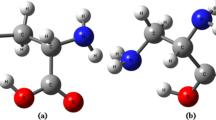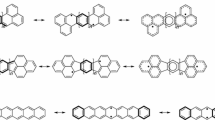Abstract
The present work reports a theoretical study of vibrational signatures of the photochromic molecular transformation between two photochromic heterocyclic isomers. Raman and infrared (IR) spectra of the E (ring-opened form) and C (ring-closed form) photoisomers of 3-Dicyclopropylmethylene-4-E-[1-(2,5-dimethyl-3-furyl)ethylidene]-5-(4-nitrophenylcyanomethylenetetrahydrofuran-2-one have been calculated in gas phase in the region of 3500–500 cm−1 for both molecules in their ground state. Calculations of the structure parameters and frontier molecular orbitals were carried out using ab initio electronic structure theory at the Hartree-Fock, density functional theory, and Moller-Plesset perturbation theory levels, while calculations of the IR and Raman spectra were carried out using density functional theory with B3LYP functional and 6-31+g(d,p) basis set. After comparing the predicted spectra of both E-form and C-form, we were able to probe the changes that arise upon the ring-closure/ring-opening transformation. The computational results showed that the C-form is ≈ 10.7 kcal/mol lower in energy than the E-form. In addition, two different derivatives were adopted for both E-form and C-form to demonstrate the effect of substituents on the stability of the photoisomers. The theoretical predictions agree well with the reported experimental data, accounting for the molecular structure transformation of the photochromic isomers.






Similar content being viewed by others
References
Wolak MA, Thomas CJ, Gillespie NB, Birge RR, Lees WJ (2003) Tuning the optical properties of fluorinated Indolylfulgimides. J Org Chem 68(2):319–326. https://doi.org/10.1021/jo026374n
Thomas CJ, Wolak MA, Birge RR, Lees WJ (2001) Improved synthesis of Indolyl Fulgides. J Org Chem 66(5):1914–1918. https://doi.org/10.1021/jo005722n
Koller FO, Schreier WJ, Schrader TE, Malkmus S, Schulz C, Dietrich S, Rück-Braun K, Braun M (2008) Ultrafast ring-closure reaction of photochromic Indolylfulgimides studied with UV-pump−IR-probe spectroscopy. J Phys Chem A 112(2):210–214. https://doi.org/10.1021/jp073545p
Parthenopoulos DA, Rentzepis PM (1990) Transient spectroscopy of a photochromic fulgide. J Mol Struct 224:297–302. https://doi.org/10.1016/0022-2860(90)87024-R
Chattoraj S, Bhattacharyya K (2016) Biological oscillations: fluorescence monitoring by confocal microscopy. Chem Phys Lett 660:1–10. https://doi.org/10.1016/j.cplett.2016.07.007
Henri Bouas-Laurent HD (2001) Organic photochromism. Pure Appl Chem 73:639–665
Seibold M, Port H, Wolf HC (1996) Fulgides as light switches for intra-Supermolecular energy transfer. Mol Cryst Liq Cryst Sci Technol, Sect A 283(1):75–80. https://doi.org/10.1080/10587259608037867
Handschuh M, Seibold M, Port H, Wolf HC (1997) Dynamics of the cyclization reaction in photochromic Furyl Fulgides. J Phys Chem A 101(4):502–506. https://doi.org/10.1021/jp961905v
Draxler S, Brust T, Malkmus S, Koller FO, Heinz B, Laimgruber S, Schulz C, Dietrich S, Rück-Braun K, Zinth W, Braun M (2008) Ultrafast reaction dynamics of the complete photo cycle of an indolylfulgimide studied by absorption, fluorescence and vibrational spectroscopy. J Mol Liq 141(3):130–136. https://doi.org/10.1016/j.molliq.2008.02.001
Heller HG, Langan JR (1981) Photochromic heterocyclic fulgides. Part 3. The use of (E)-[small alpha]-(2,5-dimethyl-3-furylethylidene)(isopropylidene)succinic anhydride as a simple convenient chemical actinometer. J Chem Soc Perkin Trans 2(2):341–343. https://doi.org/10.1039/P29810000341
Wolak MA, Gillespie NB, Thomas CJ, Birge RR, Lees WJ (2001) Optical properties of photochromic fluorinated indolylfulgides. J Photochem Photobiol A 144(2–3):83–91. https://doi.org/10.1016/S1010-6030(01)00550-0
Koller FO, Schreier WJ, Schrader TE, Sieg A, Malkmus S, Schulz C, Dietrich S, Rück-Braun K, Zinth W, Braun M (2006) Ultrafast structural dynamics of photochromic Indolylfulgimides studied by vibrational spectroscopy and DFT calculations. J Phys Chem A 110(47):12769–12776. https://doi.org/10.1021/jp0657787
Yasushi Yokoyama TG, Inoue T, Yokoyama M, Kurita Y (1988) Fulgides as efficient photochromic compounds. Role of the substituent on Furylalkylidene moiety of Furylfulgides in the photoreaction. Chem Lett 17
Trulson MO, Dollinger GD, Mathies RA (1989) Excited state structure and femtosecond ring-opening dynamics of 1,3-cyclohexadiene from absolute resonance Raman intensities. J Chem Phys 90(8):4274–4281. https://doi.org/10.1063/1.455784
Reid PJ, Doig SJ, Wickham SD, Mathies RA (1993) Photochemical ring-opening reactions are complete in picoseconds: a time-resolved UV resonance Raman study of 1,3-cyclohexadiene. J Am Chem Soc 115(11):4754–4763. https://doi.org/10.1021/ja00064a040
Mohamed TA, Hassan AE, Shaaban IA, Abuelela AM, Zoghaib WM (2017) Conformational stability, spectral analysis (infrared, Raman and NMR) and DFT calculations of 2-Amino-5-(ethylthio)-1,3,4-thiadiazole. J Mol Struct 1130:434–441. https://doi.org/10.1016/j.molstruc.2016.10.002
Shaaban IA, Hassan AE, Abuelela AM, Zoghaieb WM, Mohamed TA (2016) Infrared, Raman and NMR spectral analysis, vibrational assignments, normal coordinate analysis, and quantum mechanical calculations of 2-Amino-5-ethyl-1,3,4-thiadiazole. J Mol Struct 1103:70–81. https://doi.org/10.1016/j.molstruc.2015.09.007
Mohamed TA (2005) Some periodic trends, molecular structure, normal coordinate analysis of 1,3,5-trioxane, −trithiane and -triselenane: computational and vibrational studies. J Mol Struct (THEOCHEM) 713(1–3):179–192. https://doi.org/10.1016/j.theochem.2004.10.020
Durig JR, Ganguly A, Guirgis GA, Bell S, Mohamed TA, Gounev TK (2009) Conformational stability, r 0 structural parameters, barriers to internal rotation, ab initio calculations, and vibrational assignment for 2,2-difluoroethanol. Struct Chem 20(3):489–503. https://doi.org/10.1007/s11224-009-9446-8
Ziegler T (1991) Approximate density functional theory as a practical tool in molecular energetics and dynamics. Chem Rev 91(5):651–667. https://doi.org/10.1021/cr00005a001
Johnson BG, Fisch MJ (1994) An implementation of analytic second derivatives of the gradient-corrected density functional energy. J Chem Phys 100(10):7429–7442. https://doi.org/10.1063/1.466887
Komornicki A, Fitzgerald G (1993) Molecular gradients and hessians implemented in density functional theory. J Chem Phys 98(2):1398–1421
Dunlap BI, Andzelm J (1992) Second derivatives of the local-density-functional total energy when the local potential is fitted. Phys Rev A 45(1):81–87
Wong MW (1996) Vibrational frequency prediction using density functional theory. Chem Phys Lett 256(4):391–399
Becke AD (1993) A new mixing of Hartree–Fock and local density-functional theories. J Chem Phys 98(2):1372–1377. https://doi.org/10.1063/1.464304
Frisch MJ, Trucks GW, Schlegel HB, Scuseria GE, Robb MA, Cheeseman JR, Scalmani G, Barone V, Mennucci B, Petersson GA, Nakatsuji H, Caricato M, Li X, Hratchian HP, Izmaylov AF, Bloino J, Zheng G, Sonnenberg JL, Hada M, Ehara M, Toyota K, Fukuda R, Hasegawa J, Ishida M, Nakajima T, Honda Y, Kitao O, Nakai H, Vreven T, Montgomery Jr JA, Peralta JE, Ogliaro F, Bearpark M, Heyd JJ, Brothers E, Kudin KN, Staroverov VN, Keith T, Kobayashi R, Normand J, Raghavachari K, Rendell A, Burant JC, Iyengar SS, Tomasi J, Cossi M, Rega N, Millam JM, Klene M, Knox JE, Cross JB, Bakken V, Adamo C, Jaramillo J, Gomperts R, Stratmann RE, Yazyev O, Austin AJ, Cammi R, Pomelli C, Ochterski JW, Martin RL, Morokuma K, Zakrzewski VG, Voth GA, Salvador P, Dannenberg JJ, Dapprich S, Daniels AD, Farkas O, Foresman JB, Ortiz JV, Cioslowski J, Fox DJ (2013) Gaussian 09, revision E.01. Gaussian, Inc., Wallingford
Pulay P (1969) Ab initio calculation of force constants and equilibrium geometries in polyatomic molecules. Mol Phys 17:197–204. https://doi.org/10.1080/00268976900100941
Jensen F (2006) Introduction to computational chemistry2nd edn. Wiley, New York
Abuelela AM, Farag RS, Mohamed TA, Prezhdo OV (2013) Ab initio study of the vibrational signatures for the covalent functionalization of graphene. J Phys Chem C 117(38):19489–19498. https://doi.org/10.1021/jp405819b
Silverstein R, Webster F (2006) Spectrometric identification of organic compounds. Wiley, New York
Lin-Vien D, Colthup NB, Fateley WG, Grasselli JG (1991) The handbook of infrared and Raman characteristic frequencies of organic molecules. Academic Press INC, San Diego
Roeges NPG (1994) A guide to the complete interpretation of infrared spectral of organic structures. Wiley, New York
Abuelela AM, Mohamed TA, Prezhdo OV (2012) DFT simulation and vibrational analysis of the IR and Raman spectra of a CdSe quantum dot capped by methylamine and Trimethylphosphine oxide ligands. J Phys Chem C 116:14674–14681. https://doi.org/10.1021/jp303275v
Mohamed TA, Guirgis GA, Nashed YE, Durig JR (1999) Spectra and structure of silicon-containing compounds. XXV. Raman and infrared spectra, r0 structural parameters, vibrational assignment, and ab initio calculations of ethyl Chlorosilane-Si-d2. Struct Chem 10(5):333–348. https://doi.org/10.1023/a:1022087310109
Mohamed TA, Guirgis GA, Nashed YE, Durig JR (1998) Spectra and structures of silicon-containing compounds. XXIV.* Raman and infrared spectra, r0 structural parameters, vibrational assignment, barriers to internal rotation, and ab initio calculations of Ethylsilane. Struct Chem 9(4):255–264. https://doi.org/10.1023/a:1022426829370
Mohamed TA, Mustafa AM, Zoghaib WM, Afifi MS, Farag RS, Badr Y (2008) Reinvestigation of benzothiazoline-2-thione and 2-mercaptobenzothiazole tautomers: conformational stability, barriers to internal rotation and DFT calculations. J Mol Struct (THEOCHEM) 868(1–3):27–36. https://doi.org/10.1016/j.theochem.2008.07.037
Mohamed TA, Soliman UA, Hanafy AI, Hassan AM (2008) Conformational stability, barriers to internal rotation of 2-aminothiophenol (d 0 and d 3): a combined vibrational and theoretical approach. J Mol Struct THEOCHEM 865(1):14–24
Abuelela AM, Mohamed TA, Wilson LD, Zoghaib WM (2016) Raman and infrared spectra, normal coordinate analysis and ab initio calculations of 4-Amino-2-chloropyrimidine-5-carbonitrile. J Mol Struct 1115:85–93. https://doi.org/10.1016/j.molstruc.2016.02.082
Acknowledgments
A. M. A. F. A. A., and S. S. A. thank the Deanship of Scientific Research at King Faisal University (SA) for financial support. O. V. P. is grateful to US National Science Foundation, grant No. CHE-1565704.
Author information
Authors and Affiliations
Corresponding author
Ethics declarations
Conflict of interest
The authors declare that they have no conflict of interest.
Electronic supplementary material
ESM 1
(DOCX 140 kb)
Rights and permissions
About this article
Cite this article
Abuelela, A.M., Alodail, F.A., Al-Shihry, S.S. et al. DFT study of the infrared and Raman spectra of photochromic Fulgide; 3-Dicyclopropylmethylene-4-E-[1-(2,5-dimethyl-3-furyl)ethylidene]-5-(4-nitrophenylcyanomethylenetetrahydrofuran-2-one. Struct Chem 29, 1085–1094 (2018). https://doi.org/10.1007/s11224-018-1093-5
Received:
Accepted:
Published:
Issue Date:
DOI: https://doi.org/10.1007/s11224-018-1093-5




